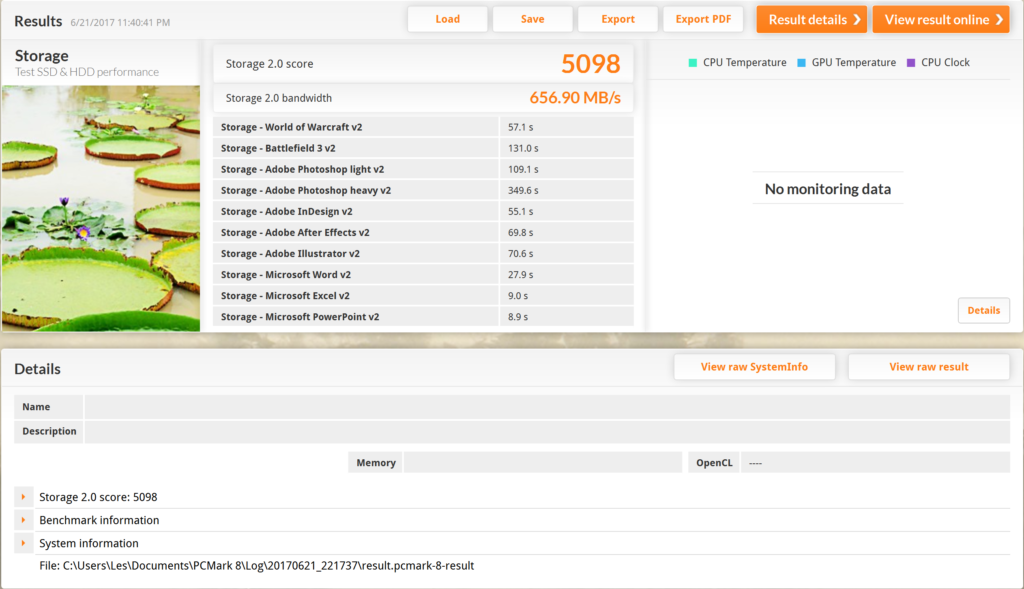The SSD Review uses PCMark 8’s Storage test suite to create testing scenarios that might be used in the typical user experience. With 10 traces recorded from Adobe Creative Suite, Microsoft Office and a selection of popular games, it covers some of the most popular light to heavy workloads. Unlike synthetic storage tests, the PCMark 8 Storage benchmark highlights real-world performance differences between storage devices. After an initial break-in cycle and three rounds of the testing, we are given a file score and bandwidth amount. The higher the score/bandwidth, the better the drive performs.
PCMARK 8 STORAGE RESULTS
In PCMark 8, the Toshiba 1TB XG5 M.2 NVMe SSD scored 5098 points and averaged 656MB/s in bandwidth.
This score places the Toshiba XG5 above all others on our chart, but for the Samsung 900 Series SSD family; this probably being the most impressive result we have seen yet.
REPORT ANALYSIS AND FINAL THOUGHTS
Early in this report, we stated that the Toshiba XG5 NVMe SSD was not available to the consumer and, come to think of it, that is not entirely true. The retail version of the XG5 will probably not show its face until later this year, but, the SSD we have reviewed here is shipping to manufacturers today and will be found within a pre-configured laptop soon enough. Toshiba’s 3rd-Gen 64-Layer BiCS 3D memory is the star of the show here and this report demonstrates just how well it performs.
Think about it for a second. Today’s laptops containing this sample XG5 are capable of storing up to 310,000 pictures, 17,000 of music, 1000 hrs of video or 500 hrs of HD movies, all the while being able to transfer data at blistering speeds above 3GB/s. And this can be done in an ultrabook weighing less than 4lbs, all the while not creating any heat concerns whatsoever. We have come a very long way.
Looking closely at our testing here, the Toshiba XG5 excels in PCMark 8 Storage Tests, which encompass a wide range of typical activities including gaming, Real World File Transfer and PCMark Vantage, all 3 tests based in real world usage scenarios. Conversely, the XG5 did not do well at all in PCMark 8 Extended Storage Consistency Testing, and this could very well be because this is an oem SSD with firmware fine tuned for the broadest range of manufacturer configurations possible. We simply have to look at the entire test strategy as a whole and consider the overall picture. This is a solid NVMe SSD (which is now in my HP Spectre by the way Toshiba) and an absolutely powerful representation of just how successful Toshiba 64-Layer BiCS 3D flash is going to become. Editors Choice!!!!
 The SSD Review The Worlds Dedicated SSD Education and Review Resource |
The SSD Review The Worlds Dedicated SSD Education and Review Resource | 


Your PCMARK 8 RESULTS graphs are in the wrong order.
Also, I’d really like to see the power usage results! You seem to ignore posting them often for an unknown reason.
Thanks for that. I will switch them up. When I test, I don’t do the power testing. I leave it to Sean with his enterprise test regime. If he happens to do consumer drives, he will do the testing because he has the equipment right there in front of him.
Well I’ve found the most interesting metric so far about NVMe SSDs is
their power usage. I have been working to create a program to estimate the total cost of ownership. In other words, I take the lifespan of the largest drive and add in the cost of each drive plus electricity and if the lifespan is too short than the cost of buying a new drive (or drives), to see how much each drive *really* costs compared to it’s competitors.
This is a really cool metric no-one seems to care about. Sadly, no-body seems to give *all* the power info about a drive. Anandntech has started, but only the info for 2 or 3 drives is available.
Thanks for your reviews, and please encourage Sean!
Consumer and oem SSDs. The SSD will be replaced long before cost of ownership will be considered. Next up…power usage. It is not a major consideration, if any at all, with consumer SSD buyers. That is why we reserve our enterprise reviews for such. Don’t get me wrong. I am not discrediting you at all but, in most cases, SSDs are received only 3-4 days prior to when the embargo is when the report is to be released. Trust me when I say reviewers work their asses off to get an accurate report out in a very small period of time. It is not uncommon whatsoever to receive a SSD on Friday, without warning, for review release Monday morning…when you had a weekend planned. For many, the pay for doing such is very little if not non-existent. Many work on retention alone in the tech world. Just a peek into the SSD review lifestyle…
I totally understand. Its a cruel world sometimes.
What I have always wondered is, what happens if you get your review out 1 or 2 days after the embargo expires?
Let’s face it, you can give a better review if you have more time, plus you can think about what you are writing vs. being in a mad rush.
Personally, I typically am the last person to have an opinion on a given topic, but mine are far more accurate because I do the research and take the time to go through all of what I know and have learned.